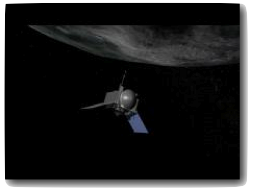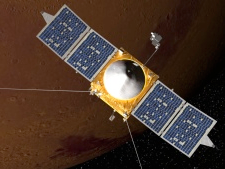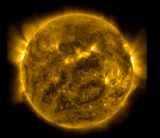NASA is tracking a large near-Earth asteroid as it passes by the Earth-Moon system on May 31st. Amateur astronomers in the northern hemisphere may be able to see the space rock for themselves during the 1st week of June. The closest approach of the asteroid occurs on May 31 at 4:59 p.m. EDT, when the asteroid will get no closer than about 5.8 million kilometers, or about 15 times the distance between Earth and the moon.
Approaching asteroid 1998 QE2 has a moon. Researchers found it in a sequence of radar images obtained by the 70-meter Deep Space Network antenna at Goldstone, Calif., on the evening of May 29th (May 30th Universal Time) when the asteroid was about 6 million kilometers from Earth.
For more information about Asteroids and OSIRIS-REx, log into the NES Virtual Campus and check out these three NASA Now classroom videos:
• Earth and Space Science: Asteroids
• Exploring Asteroids: An Analog Mission
• Primitive Asteroids: OSIRIS-REx
To read more and see a video about asteroid 1998 QE2 go to Science@NASA.
Link to the NASA Explorer Schools home page.

 NASA’s first mission to sample an asteroid is moving ahead into development and testing in preparation for its launch in 2016.
NASA’s first mission to sample an asteroid is moving ahead into development and testing in preparation for its launch in 2016.
 In this NASA Now classroom video, you’ll hear from three career engineers at NASA Langley Research Center who work in very different fields. They discuss the unique projects they are working on and how science, technology, engineering and mathematics education played a role in their career path to NASA.
In this NASA Now classroom video, you’ll hear from three career engineers at NASA Langley Research Center who work in very different fields. They discuss the unique projects they are working on and how science, technology, engineering and mathematics education played a role in their career path to NASA. If you missed out on the opportunity to send your name to Mars as part of the Curiosity mission (see the NES Teachers Corner article,
If you missed out on the opportunity to send your name to Mars as part of the Curiosity mission (see the NES Teachers Corner article,  In the three years since it first provided images of the sun, NASA’s Solar Dynamics Observatory has had virtually unbroken coverage of the sun’s rise toward solar maximum, the peak of solar activity in its regular 11-year cycle.
In the three years since it first provided images of the sun, NASA’s Solar Dynamics Observatory has had virtually unbroken coverage of the sun’s rise toward solar maximum, the peak of solar activity in its regular 11-year cycle.